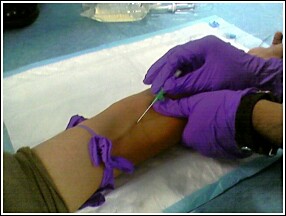Jack’s Health Part A: Type II Diabetes Mellitus (TIIDM)
- Jack felt he had nothing to offer his children (Nancy & Phillip)
- He had lost his ancestral heritage
- He often took Nancy fishing & hunting
- He attended his daughter’s sports events
- Did not spend much time with Phillip
- Worked hard to provide for his family
- He loved his wife Mary, but often missed the family & culture he grew up with
Signs and Symptoms
You can live with type II DM for years and not know it. Signs & Symptoms of TIIDM can develop slowly like:
CNS symptoms
- Increased thirst
- Frequent urination
- Increased hunger
- Blurred vision
Immune symptoms
- Slow-healing sores
- Frequent infections
PNS symptoms
- Numbness or tingling in hands or feet
- Areas of darkened skin, usually in the armpits & neck
Other Symptoms
- Unintended weight loss
- Fatigue
Causes
Type II DM is primarily the result of two interrelated problems: Insulin resistance & Insulin receptors are not responding to insulin.
- Cells in muscle, fat, and the liver become resilient to insulin.
- Because these cells don’t interact in a normal way with insulin, they don’t take in enough sugar.
- The pancreas is unable to produce enough insulin to manage blood sugar levels.

How Insulin Works
Insulin is a hormone that comes from the pancreas & regulates how the body uses sugar in the following ways:
- Sugar in the bloodstream triggers the pancreas to secrete insulin
- Insulin circulates in the bloodstream, enabling sugar to enter the cells
- The amount of sugar in the bloodstream drops
- In response to this drop, the pancreas releases less insulin

The Role of Glucose
Glucose – a sugar – is a main source of energy for the cells that make up muscles and other tissue. The use & regulation of glucose includes:
- Glucose is made and stored by the liver
- It comes from 2 major sources: food & the liver
- It is absorbed into the bloodstream, where it enters cells via insulin
- When glucose levels are low, the liver breaks down stored glycogen into glucose
In type II DM, this process does not work well. Sugar does not enter the cells, builds up in bloodstream. The beta cells in the pancreas release more insulin. Eventually these cells become impaired.
In type I DM, the immune system mistakenly destroys the beta cells, leaving the body with little to no insulin.
Risk Factors
- Weight – being overweight or obese is a main risk
- Fat distribution – storing fat mainly in the abdomen (men waist >40 inches, women waist >35 inches)
- Inactivity – physical activity keeps weight done, and uses up glucose as energy, makes cells more sensitive to insulin
- Family history – increases if parent or sibling has type II DM
- Race & ethnicity – Black, Hispanic, Indigenous, Asian, Pacific Islanders
- Blood lipid levels – increased risk associated with love levels of HDL cholesterol and high levels of triglycerides
- Age – increases with age, especially after age 45
- Prediabetes – blood sugars higher than normal, but not high enough to be classified as diabetes, if left untreated often progresses to type II DM
- Pregnancy-related risks – increases if you develop gestational diabetes or if you give birth to a baby weighing > 9 pounds
- Polycystic ovary syndrome – common condition characterized by irregular menstrual periods, excess hair growth and obesity-increases the risk of diabetes
Which of these risk factors apply to Jack?
Back to Jack
Based on some of Jack’s symptoms and risk factors, he gets blood work done to assess his blood-glucose levels. Jack worked hard to maintain the home that he has shared with his wife for almost 50 years.

What affects blood-glucose levels?
Glucose concentration is affected by:
- Collection time (random, fasting, 2hr, etc.)
- Specimen transport and handling
- Type of specimen (plasma/serum/whole blood)
- What type of blood was collected (venous/capillary/arterial)
- Type of analysis (possible interferences)
Q&A
Which one of this may be a problem when performing glucose tests on Jack?
Acetaminophen causes large positive bias on some meters and moderate negative bias on other meters
Where would we use whole blood for glucose testing?
In POCT (point of care testing) -Glucometer
Which of these are preanalytical factors?
Type of analysis
Which of these are analytical factors
Collection time, transport, type of specimen, collection source
More potential tests for Jack
Diabetes can be diagnosed by:
- Fasting Blood Sugar (FBS) > 7.0 mmol/L
- Random Blood Sugar (RBS) > 11.1 mmol/L + symptoms of diabetes
- 2 Hour Post Cibum (2hPC) in a 75g oral glucose tolerance test (OGTT) > 11.1 mmol/L
Collection tubes MUST be centrifuged immediately!
- Requires separation of plasma from cells
- Cells remain viable in collection tube and continue to perform glycolysis!
- Serum glucose drops 5-7% in 1 hour in uncentrifuged blood at room temperature
- When centrifuged, glucose is stable for ~8hr at room temperature or ~72hr at 4°C

Diabetes Diagnosis
Routine Urine Dipstick Testing
- Urine glucose normally NEG
- Uses reaction VERY specific for GLUCOSE 🡪 cannot detect other sugars!
Manual Benedict’s test: done to determine which sugar is present
- GLUCOSE, GALACTOSE, LACTOSE, FRUCTOSE
- These tests must be done in combination to see if any of the other reducing sugars are present

Q&A
If dipstick shows POSITIVE, what sugars are present?
Glucose
If dipstick shows NEGATIVE, what sugars are present?
Lactose, galactose or fructose possible, or no sugars – Benedict’s test will confirm
Jack being diagnosed with TIIDM
Jack was diagnosed with type II diabetes mellitus just before he turned 50 years of age. He now has to take short-acting insulin with meals. Jack required insulin injections, because his meal planning, weight loss, exercise and prescribed medications did not achieve targeted blood glucose (sugar) levels.
Prescribing Jack’s Insulin Mixture
For convenience, there are premixed rapid- and intermediate-acting insulin. The insulin will start to work as quickly as the fastest-acting insulin in the combination. It will peak when each type of insulin typically peaks, and lasts as long as the longest-acting insulin
Examples include:
- 30% regular and 70% NPH (Humulin 30/70, Novolin ge 30/70).
- 50% lispro and 50% lispro protamine (Humalog Mix 50).
- 25% lispro and 75% lispro protamine (Humalog Mix 25).
- 30% aspart and 70% aspart protamine (NovoMix 30).

Acute Crisis Situation
Jack has not been in good control of his glucose levels since his wife Mary has been in the hospital. This puts him at risk for:
Hyperosmotic Nonketotic Hyperglycemia (HONK)
Hyperosmotic Hyperglycemic Nonketotic Syndrome (HNNS)
- Characterized by glucose levels >35 mmol/L with NO ketoacidosis
- Can see levels >50 mmol/L!
- Insulin levels prevent ketosis via lipolysis, but cannot prevent hyperglycemia & osmotic diuresis
- FATAL if not treated!
- Mortality rate: 10-20%

Jack suffers complications from his TIIDM
Over the last 5 years, Jack has been struggling with pain and numbness in his feet which has affected his ability to maintain his home. Jack started doing less and less as time went on due to the pain and numbness.

Complications & Frequent Comorbidities
Autonomic Neuropathy
- Eye damage – cataracts and glaucoma, may damage the blood vessels in the retina
- Kidney disease – may lead to irreversible end-stage kidney disease
- Heart & blood vessel disease – increase risk of heart disease, stroke, hypertension, and atherosclerosis

Peripheral Neuropathy
- Neuropathy in limbs
- Nerve damage
- Skin conditions – more susceptible to bacterial and fungal infections
- Slow healing – cuts and blisters can become seriously infected, severe damage might require amputation
- Hearing impairment
- Sleep apnea – obstructive sleep apnea is common, obesity may be the main contributing factor. Not clear if treating sleep apnea improves blood sugar control
- Dementia – seems to increase risk of Alzheimer’s disease and other dementia disorders. Poor blood sugar control linked to more-rapid decline in memory and thinking skills
Which of these complications are present in Jack’s case?
Preventing Diabetes
- 30 minutes of activity per day five days per week helps lower risk of developing type II diabetes by 58%
- Monitor and/or lower your blood pressure & cholesterol
- Eat a healthy diet, less fats, more fiber, whole grains, veggies, fruits, lean meats


